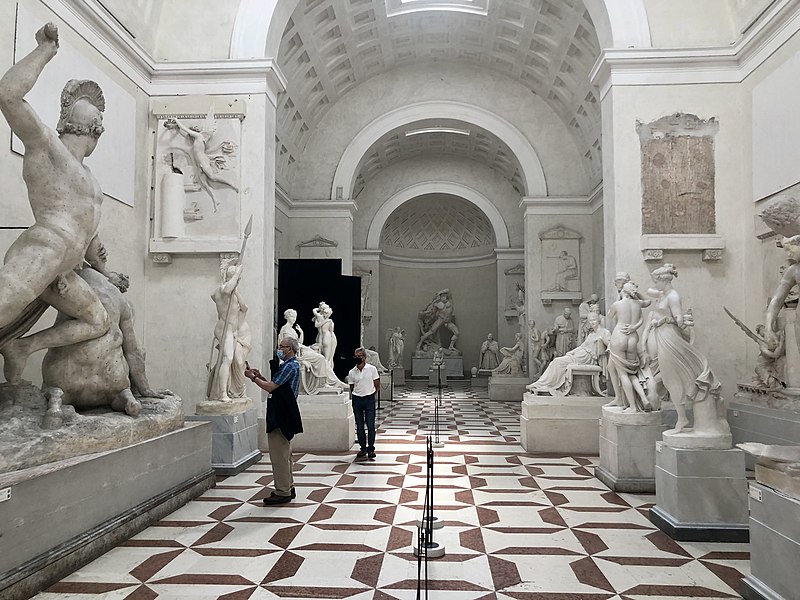Between the eighteenth and nineteenth centuries, in full neoclassicism, there was an artist-genius acclaimed by all at an international level, and his name was Antonio Canova. Born in the province of Treviso in 1757, this year we celebrate the 200th anniversary of his death, which arrived on 13 October 1822 in Venice. All of Italy is preparing with a rich calendar of events.
Antonio Canova, the new Phidias
Possagno, a tiny Treviso village of two thousand inhabitants nestled on the Asolo hills, would be completely unknown to history if in 1757 it had not given birth to one of the greatest artists in the history of Western art: Antonio Canova. With an architect father and a stonecutter grandfather, little Canova could only be born with art in his veins. Just 11 years old tone he arrives in Venice and begins to breathe art at very high levels: another ten years are enough for him to be recognized as an artist of great skill and sensitivity. In a short time his sculptures of him begin to travel all over Europe to the homes of the most influential personalities, from which he is recognized as a "new Phidias", referring to the sculptor of the works of the Parthenon in Athens.

A man of rare intelligence, he made friends with some important men of culture of the time, from the artist Jean-Louis David to the poets John Keats and Ugo Foscolo. In 1815 he comes invited to Paris to recover the works taken away from Italy by Napoleon with the treaty of Tolentino. Despite his aversion to the emperor for destroying the Venetian Republic, he succeeds in an enterprise for which the Italians must still be enormously grateful to him. He died in 1822, at the age of 65, hailed by the world as the greatest artist of the time.
Strokes of genius
There are many reasons, in addition to his great artistic ability, why Canova's genius deserves to be celebrated. First of all to have revolutionized the methods of making marble works. Canova was in fact the first to make marbles “in series” starting from a life-size plaster model. He started with a sketch on paper, then passing through a clay model, and then the plaster sculpture, on which "nails" called repere. Through these points of reference and the use of specific tools, the master's workshop was able to replicate several examples in marble of the same subject. That is why we have more than one Hebe, more than one dancer, more copies of the group of the Three Graces and so on.

Furthermore, Canova had the intuition to have the drawings of his works "printed". Thanks to the printing technique, it was possible to replicate the same drawing in tens or even hundreds of copies and have it circulated throughout Europe. A sort of ante litteram catalog which allowed him to send his works to any interested clients.
In memory of Antonio Canova
For this important bicentennial a respectable event calendar is planned. His Veneto is ready to give him exhibitions and events throughout 2022, starting right from Possagno's (TV). The Canova Museum, born in the artist's birthplace, invested 784 thousand euros in public funds made available through a tender from the Ministry of Culture to restore and digitize Canova's architectural complex. The exhibition will be inaugurated in Treviso on 25 March The nineteenth century unveiled. From Canova to historical Romanticism, which can be visited at Bailo Museum which will house the famous plaster of Cupid and Psyche.

The exhibition has already been inaugurated and can be visited until 18 April Canova. Between innocence and sin al MART of Rovereto, which showcases the master's works under the gaze of great photographers and beyond. Photography is once again the protagonist at the In light exhibition. Photographs by Alessandra Chemollo in the Gypsoteca of Possagno open in December 2021 at Querini Stampalia Foundation Venice.
The rediscovered work
The exhibition deserves a special mention Ebe set up ai Civic Museums of Bassano del Grappa (VI) until May 30th. The protagonist is Ebe himself, the cup holder of the gods and repeatedly sculpted in marble by Canova and his workshop. In this exhibition the plaster work of 1817 is finally brought to light, kept right in Bassano which was damaged by the splinters of a bomb that exploded in the city of Grappa during the Second World War. Through state-of-the-art restoration techniques it was possible to reconstruct the work, which finally returns to shine in the cultural heritage of the area. The exhibition, in addition to illustrating the ambitious restoration project, also exhibits paintings, drawings and ancient illustrated books, as well as an in-depth study on the mythological figure of Hebe, symbol of eternal youth.
Photo source in evidence: Ebe exhibition at the Civic Museums of Bassano del Grappa





